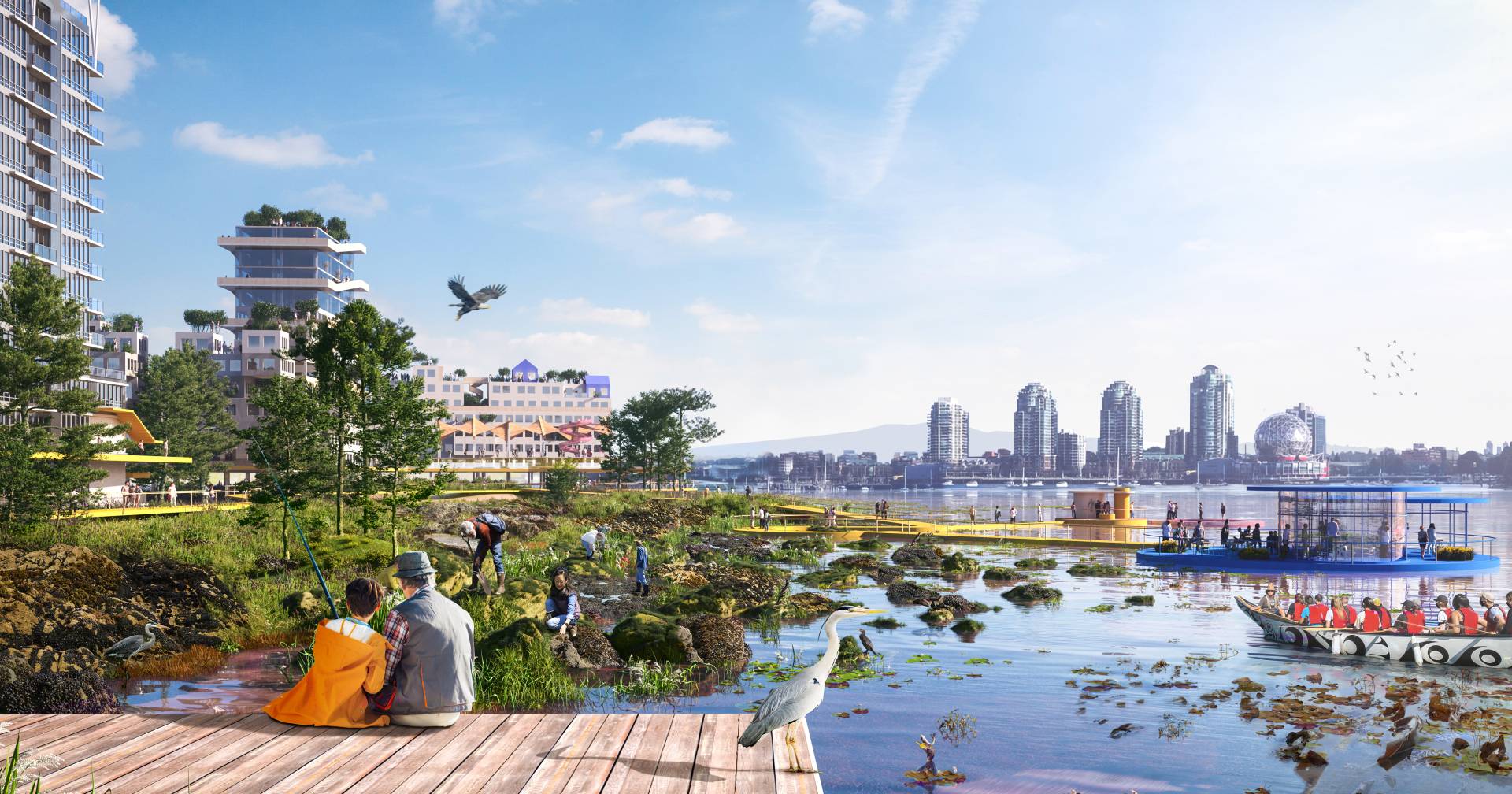Five impactful lessons we learned on the Sea2City Design Challenge
Published
When designing with living systems, we recognize the impossibility of a project ever really being "done." This feels especially true for the Sea2City Design Challenge. Our team has reflected on the incredible experience, the privilege of working on this project and the lessons we learned.
Learn more about the Sea2City Design Challenge here.
Sea2City Lesson #1: Language is a powerful design driver.
A key aspect in adapting to sea level rise in Vancouver's False Creek Basin is finding the right language to guide our design response. This was perhaps the most important lesson taught by Charlene Aleck, the project’s Indigenous Knowledge Holder from the Tsleil-Waututh Nation, who helped us recognize that our words can significantly impact our understanding of the problem and our ability to recognize a solution. We came to understand that the typical language of Adaptation was steeped in colonial connotations of "resist," "accommodate," and "retreat" - terminology that positions our relationship with water and nature in an adversarial way.
By rewording these approaches to reflect Indigenous values better, the project team was compelled to rethink the design response completely. These realizations were not only enriching for us personally but also wholly informed our design thinking from the early stages of the project.
Sea2City Lesson #2: Acknowledge what was, what is, and what could be.
The focus of Sea2City on addressing sea level rise in Vancouver's False Creek Basin was informed by another essential lesson shared by Charlene Aleck, the project's Indigenous Knowledge Holder of the Tsleil-Waututh Nation. We are in a climate emergency, and it is essential that we understand how we got here, what the challenges are, and what we need to do to fix them. This requires critical reflection and acknowledgment and a meaningful commitment to decolonize the processes and systems that have led to our current situation.
By acknowledging what was, what is, and what could be, we can create a vibrant, fair and regenerative future for False Creek where all inhabitants can recognize themselves and feel attached to the place.
Sea2City Lesson #3: We need to slow down when times are urgent.
The past few years have undeniably demonstrated climate change's staggering speed and impact and the often inefficient rate at which humans are capable—or willing—to respond. It sounds contradictory, but this lesson from the Sea2City Design Challenge describes what we learned about the necessity of slowing down amid crisis to recognize the risk of rushing into reactive patterns instead of seeing the lessons and opportunities surrounding us. For our team, this meant taking time to connect with a broad range of perspectives beyond the pressure of "productivity" within the confines of our respective bubbles. Informal conversations outside of the studio environment provided essential sparks of inspiration and understanding, which accelerated our ability to respond with intention and impact.
Sea2City Lesson #4: Prioritize floodplains, not flood walls.
Another lesson that may seem counter-intuitive: if recognized for their inherent qualities, floodplains reduce flooding by providing an increased area for the storage and slow movement of water. Human interventions (landfilling, diking, urbanization, etc.) disrupt a floodplain's natural function and, ironically, create new risks when water is viewed primarily as a threat.
False Creek was built on a floodplain, which should be celebrated, not denied. Our conversations with engineers, ecologists, Indigenous Knowledge Holders, residents, and planners reminded us that restoring natural systems is a valuable and effective flood management response. The Sea2City Design Challenge prioritized an integrated flood management response that included a variety of solutions to restore, maintain, or augment the function and productivity of the natural floodplain to provide long-term, resilient protection and management of rising sea levels.
Sea2City Lesson #5: We need to "dive in".
We've talked about the lessons related to slowing down, looking back, and looking forward. This final lesson builds on those reflections, recognizing that long-term objectives require near-term decisions and actions. The main lesson is that we can’t be afraid to get our feet wet: exploration and experimentation are essential parts of the process. In the face of uncertainty, pilot projects can be immediately initiated to explore ideas, investigate what works and nurture a renewed sense of collective action in False Creek. Pilot projects could be bold ideas that test and advance innovative technologies or traditional nature-based solutions that plant the seeds for urban ecologies of the future.
—
As a team, we are passionate and inspired to continue our efforts on impact-driven work that supports climate adaptation and prepares our communities for a resilient future. We'll continue sharing ideas and nature-based strategies informed by our experience in this process.
If you're working on any inspiring projects or research related to sea level rise, let us know! We'd love to continue the dialogue of learning, sharing and advocating for resilient, inclusive, and creative solutions for a climate-changed future.
Follow us on Instagram to continue the conversation.
Project Collaborators: MVRDV, Modern Formline Design, Deltares, Happy Cities, Westmar Advisors, Gary Williams, Goudappel, Modus Planning, Design & Engagement
